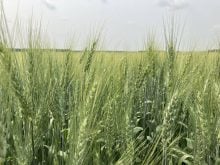The Canadian Grain Commission could soon change the way it classifies Canadian barley.
It is assessing a plan to replace Canada’s existing hulless barley class with a new food barley classification.
The new class, if approved, would include hulled and hulless barley varieties that are suitable for milling, pearling and other food-related uses.
Terry Young, an Alberta barley grower and member of the Western Standards Committee, said Canadian consumers are warming up to food that contains barley ingredients.
A food barley class would provide an effective marketing tool for food manufacturers and could result in better prices for Canadian barley producers.
Read Also

Why feds imposed EV tariffs
Moe and Kinew have a fight on their hands when it comes to eliminating the EV tariff. Canada has to worry about pissing off the U.S. and Mexico and hundreds of thousands of auto workers.
“The intent for barley producers and the barley industry is to increase demand,” said Young.
“Our demographic is getting older. We have a lot of baby boomers and they want healthy products, so we think we can attract some consumers to barley.”
The push to create a new food barley class is part of a larger industry-wide effort to expand barley use beyond the malting and animal feed markets.
Barley use by the food manufacturing industry is still relatively small, but consumer demand for healthy products is growing. The Canadian barley industry is hoping to capture its share of the growing specialty health food market.
Young said the industry would like the new food barley designation to be in place by August 2012, before Health Canada completes deliberations on an industry request to recognize the crop as a health promoting food ingredient.
The industry claims that barley reduces cholesterol levels and slows glucose absorption in diabetics.
If Health Canada endorses that claim, food manufacturers would be allowed to include it on the labels of products that contain barley ingredients.
Health Canada approved a similar health claim last November that was submitted by the Canadian oat industry.
Creating a new food barley class at the grain commission and securing a government-endorsed health claim would expand barley use and enhance the crop’s reputation among health conscious consumers, Young said.
The commission now divides barley into three classes: malting, hulless and general purpose.
Darryl Beswitherick, quality assurance manager for the grain commission, said the food class, if approved, would primarily serve as a marketing tool for the barley and food manufacturing industries.
“There’s been a lot in the news recently about barley and the value of it in food and its health benefits,” Beswitherick said.
“It is a pretty small niche market right now … but it’s something that we’re trying to be proactive about in terms of developing a grade schedule … that is relevant to the food industry.”
Beswitherick said producers wouldn’t likely notice any immediate impact if the new classification was approved.
However, Young suggested that it could result in premium prices and more identity preserved contracts for the production of designated food barley varieties.
“Australia already has a food barley class, and there are a number of other jurisdictions that do as well,” said Young.
“End users and food manufacturers see a need for a food barley class because they don’t want to tell consumers that they’re using a feed barley or a general purpose barley (in food production).”
The experts examining the proposal were scheduled to meet this week, said Beswitherick.
They will likely present their findings in late October before the fall meeting of the Western Standards Committee.
The committee advises the commission on grading and classification issues.
BARLEY BENEFITS
•Barley can be milled to produce flour for pancakes and muffins, flakes similar to rolled oats for breakfast cereal, and bran for healthy diets.
•Whole grain hulless barley contains various nutrients and is rich in beta glucan, a type of carbohydrate that plays a role in regulating glucose and cholesterol.
•Whole grain hulless barley is low on the glycemic index (GI).
•Low GI food assists in the prevention of Type 2 diabetes and helps maintain healthy blood sugar and blood cholesterol levels.
•Barley is a rich source of soluble and insoluble fibre.
•Hulless barley contains fibre throughout the entire grain and not just in the outer portion.
•Barley’s soluble fibre slows the absorption of glucose into the bloodstream, resulting in a feeling of fullness that may help control weight gain.
Source: Alberta Barley Commission















